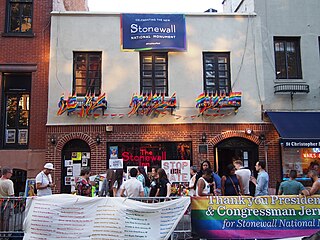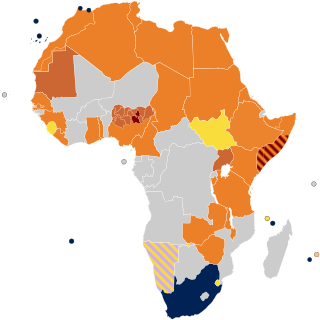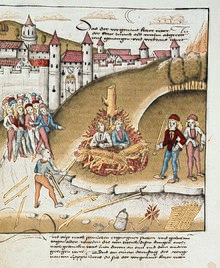
Lesbian, gay, bisexual, transgender and queer (LGBTQ) movements are social movements that advocate for LGBTQ people in society. Although there is not a primary or an overarching central organization that represents all LGBTQ people and their interests, numerous LGBTQ rights organizations are active worldwide. The first organization to promote LGBTQ rights was the Scientific-Humanitarian Committee, founded in 1897 in Berlin.
Heteronormativity is the concept that heterosexuality is the preferred or normal sexual orientation. It assumes the gender binary and that sexual and marital relations are most fitting between people of opposite sex.

Biphobia is aversion toward bisexuality or people who are identified or perceived as being bisexual. Similarly to homophobia, it refers to hatred and prejudice specifically against those identified or perceived as being in the bisexual community. It can take the form of denial that bisexuality is a genuine sexual orientation, or of negative stereotypes about people who are bisexual. Other forms of biphobia include bisexual erasure. Biphobia may also avert towards other sexualities attracted to multiple genders such as pansexuality or polysexuality, as the idea of being attracted to multiple genders is generally the cause of stigma towards bisexuality.
Lesbian, gay, bisexual, transgender, and queer (LGBTQ) personnel are able to serve in the armed forces of some countries around the world: the vast majority of industrialized, Western countries including some South American countries, such as Argentina, Brazil and Chile in addition to other countries, such as the United States, Canada, Japan, Australia, Mexico, France, Finland, Denmark and Israel. The rights concerning intersex people are more vague.
A sexual minority is a demographic whose sexual identity, orientation or practices differ from the majority of the surrounding society. Primarily used to refer to lesbian, gay, bisexual, or non-heterosexual individuals, it can also refer to transgender, non-binary or intersex individuals.

LGBTQ stereotypes are stereotypes about lesbian, gay, bisexual, transgender, and queer (LGBTQ) people based on their sexual orientations, gender identities, or gender expressions. Stereotypical perceptions may be acquired through interactions with parents, teachers, peers and mass media, or, more generally, through a lack of firsthand familiarity, resulting in an increased reliance on generalizations.

Bisexual erasure, also called bisexual invisibility, is the tendency to ignore, remove, falsify, or re-explain evidence of bisexuality in history, academia, the news media, and other primary sources.

The United States recognizes the right of asylum for individuals seeking protections from persecution, as specified by international and federal law. People who seek protection while outside the U.S. are termed refugees, while people who seek protection from inside the U.S. are termed asylum seekers. Those who are granted asylum are termed asylees.

The questioning of one's sexual orientation, sexual identity, gender, or all three is a process of exploration by people who may be unsure, still exploring, or concerned about applying a social label to themselves for various reasons. The letter "Q" is sometimes added to the end of the acronym LGBT ; the "Q" can refer to either queer or questioning.
This article focuses on Japanese definitions of gender and sexuality, Japanese reactions to queer life, the clash between traditional and contemporary ideas, and the cultural restraints of being queer in Japan. The Western term “queer,” an umbrella term for lesbian, gay, bisexual, and transgender (LGBT) represents a change in thought pertaining to gender and sexuality in contemporary Japan.

Lesbian, gay, bisexual, and transgender (LGBT) rights in Africa are generally poor in comparison to the Americas, Western Europe, and Oceania.

Lionel Cantú Jr., was an assistant professor of sociology at the University of California, Santa Cruz, who focused on queer theory, queer issues, and Latin American immigration. His groundbreaking dissertation, The Sexuality of Migration: Border Crossings and Mexican Immigrant Men, which was edited, compiled, and published posthumously, focuses on the experiences of Mexican-queer migrants.

Lesbian, gay, bisexual, and transgender (LGBT) people generally have limited or highly restrictive rights in most parts of the Middle East, and are open to hostility in others. Sex between men is illegal in 9 of the 18 countries that make up the region. It is punishable by death in four of these 18 countries. The rights and freedoms of LGBT citizens are strongly influenced by the prevailing cultural traditions and religious mores of people living in the region – particularly Islam.

The following outline offers an overview and guide to LGBTQ topics:

In Canada, Lesbian, Gay, Bisexual, or Transgender (LGBT) or Gender and Sexual Minority (GSM) refugees and asylum-seekers are those who make refugee claims to Canada due to their sexual orientation or gender identity.
Queer erasure refers to the tendency to intentionally or unintentionally remove LGBT groups or people from record, or downplay their significance, which includes lesbian, gay, bisexual, transgender, and queer people. This erasure can be found in a number of written and oral texts, including popular and scholarly texts.
Christine Morrissey is a Canadian LGBT activist who challenged immigration laws and has led organizations that support LGBT newcomers, refugees and asylum seekers. She is a recipient of the Officer of the Order of Canada award.
Transgender asylum seekers are transgender people seeking refuge in another country due to stigmatization or persecution in their home countries. Because of their gender non-conformity, transgender asylum seekers face elevated risks to their mental and physical health compared to cisgender asylum seekers or those whose gender identity is the same as their sex assigned at birth, including higher risks of physical and sexual assault, torture, "conversion therapy" practices, and forced isolation. As a result, transgender people face challenges in the asylum process not experienced by others.











